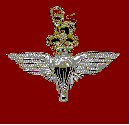

The Parachute Regiment was formed as the result of a call by Winston Churchill, in June of 1940, for the raising of 'a corps of at least five thousand parachute troops'. The first step was the establishment of the first Parachute Training School at Ringway, near Manchester. Training and dropping was the responsibility of the Royal Air Force and continues to this day. The initial unit selected for parachute training was No 2 Commando this title was changed to the 11th Special Air Service and later to 1st Parachute Battalion and finally to the 1st Parachute Battalions in the 1st Parachute Brigade. The 1st Parachute Brigade was formed under Brigadier R. N. Gale, OBE MC
In October 1941 an Airborne Division was formed by Major General F A M Browning DSO. General Browning guided the formation of The Parachute Regiment which established as Regiment on August 1st 1942. The Regiment during the Second World War grew to 17 battalions, several independent pathfinder units. Five of these Battalions were formed overseas, three in India and two in Egypt. The Regiment was made up of volunteers who came from all infantry regiments, as well as the Guards Brigade. A volunteers initial tour was for three years but additional tours were permitted.
The Regiment first saw action in 1941 when an experimental drop was made on the Tragino aqueduct in Apulia, Italy. The next raid came on February 17 1942 with a successful attack by 'C' Company of the 2nd Battalion at on the French Coast. The target was a German radar installation. Shortly after this raid the maroon beret was adopted as the head gear of the Regiment. Actions at a number of locations and principally at Oudna in North Africa were carried out by the 1st Parachute Brigade in November of 1942. The fighting was fierce and it was in these actions that the Regiment earned the name 'RED DEVILS' from the Germans. The Regiment continued to see action in North Africa through the Spring of 1943 with action at Tamera in the March of that year.
In July of 1943 action moved to Sicily and 1st Parachute Brigade's seizing the Primosole Bridge. The 2nd Independent Parachute Brigade saw action in Italy, Southern France and Athens, Greece during 1943 and 1944. The 1st Brigade with the 4th Brigade returned to the United Kingdom to prepare for the Normandy invasion.
The Normandy Landing in June 1944 was the first division sized airborne operation of the Second World War. The 6th Airborne Division included the 3rd and 5th Parachute and the Air Landing Brigades, Major General R. N. Gale OBE MC was the commander of 6th Airborne Division on D Day.
Among the famous actions conducted by British Airborne Forces in North West Europe was the Battle of Arnhem, September 17th 1944. The 1st, 4th and the 1st Polish Independent Parachute and the 1st Air Landing Brigades with the 82nd and 101st US Airborne Divisions formed the 1st British Airborne Corps.
This Corps in March 1945 took part in the Rhine Crossing and continued as a Corps until wars end in May of 1945. The Regiment saw action in the Far East before the cessation of all hostilities in 1946.
In the post war years the Regiment has served and seen action world wide, Palestine, Germany, the Middle East where in 1956 the last Battalion combat jump took place at Port Said. Peace keeping and other operations has seen the Regiment serving in Cyprus (64), Radfan (64), Borneo (65), and Aden (67). The 1st, 2nd, and 3rd Battalions have all seen service in Northern Ireland during the 1960's and 70's. In 1982 the 2nd and 3rd Battalions were part of Operation Corporate in the Falkland Islands. As a result of this action two members of the Regiment were posthumously awarded the Victoria Cross.
 |
 |